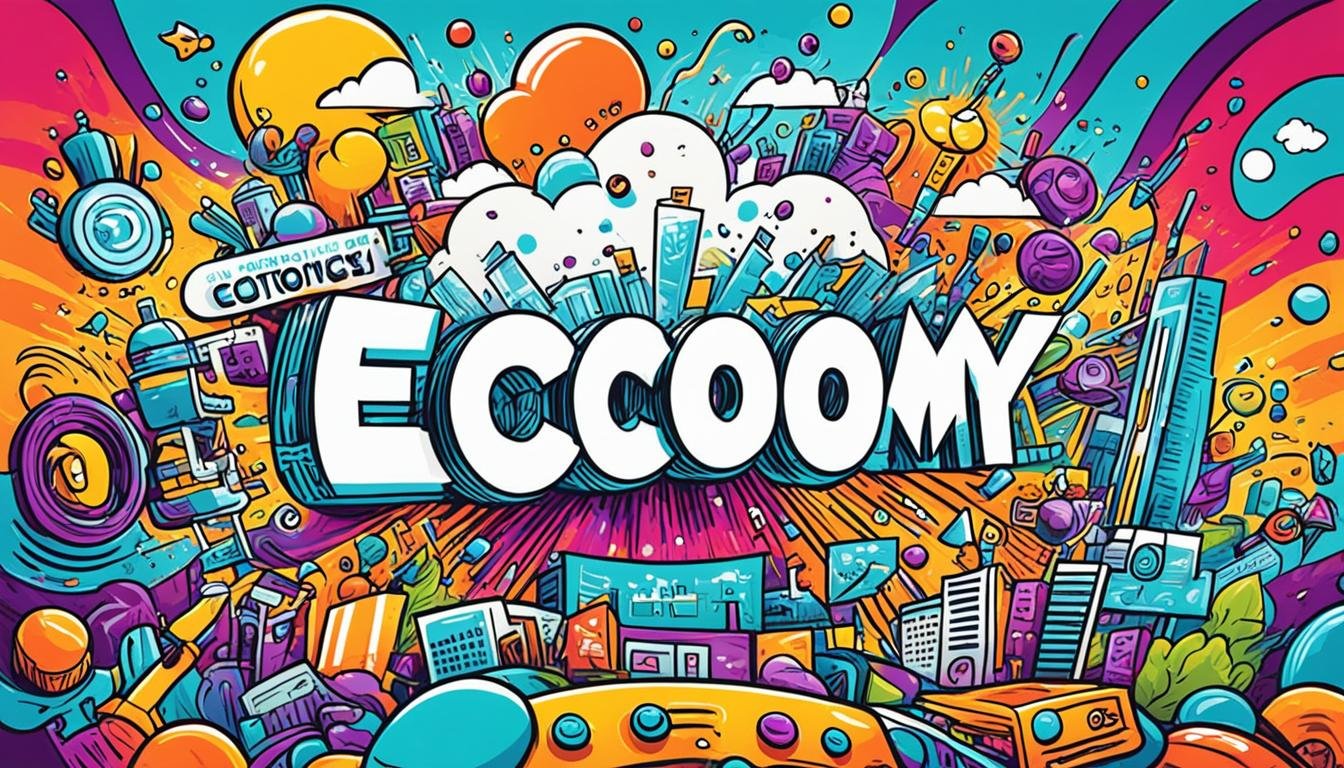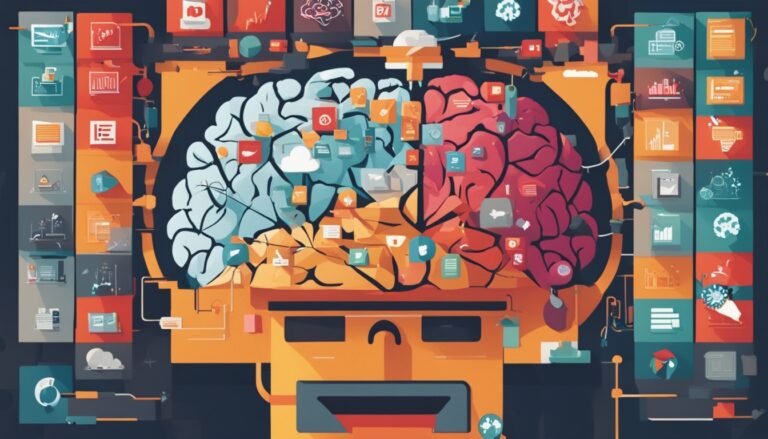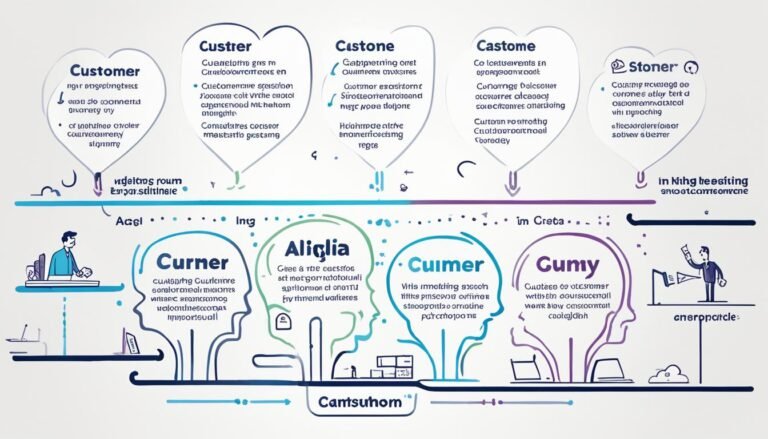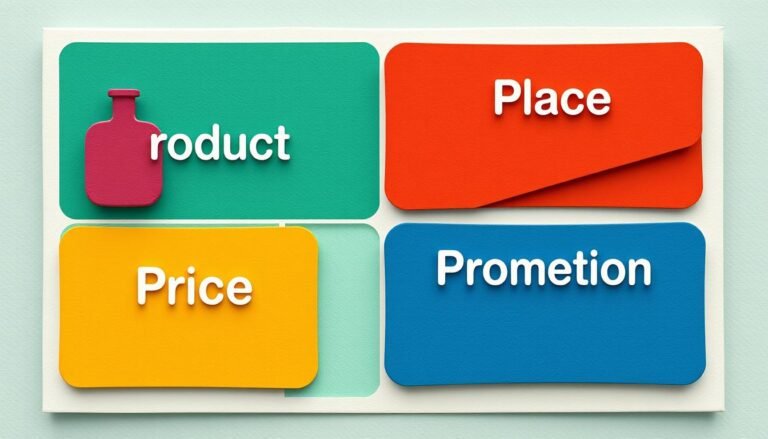Experience Economy: Creating Memorable Customer Experiences
Did you know that 88% of customers say customer experience is key in their buying choices? This is right up there with the quality of goods and services. With so many options out there, the experience economy is booming and expected to hit $12 billion by 2023. People now look for quality in how brands interact with them, and 86% are ready to pay more for a great customer experience.
This change is more than just a passing trend. It’s a big shift in how companies connect with customers through customer engagement and brand storytelling.
The experience economy is all about creating memorable events that customers cherish more than just products and services. Since it was first talked about in the late 1990s, it’s shown how crucial it is to design experiences that are personal and engaging. Now, companies are all about making emotional connections to make customers happy and stand out.
By focusing on customer engagement through the experience economy, companies can make their customers’ lives better and build strong, lasting relationships. Brands like Starbucks and Lush are great examples. They use unique experiences to keep customers coming back and build loyalty.
Key Takeaways
- 88% of customers prioritize customer experience in their buying decisions.
- 86% of consumers are willing to pay more for outstanding customer experiences.
- Memorable experiences foster customer delight and brand loyalty.
- Experience economy projected to reach $12 billion by 2023.
- Businesses like Starbucks and Lush exemplify effective experience-driven engagement.
Understanding the Experience Economy
In 1998, B. Joseph Pine II and James H. Gilmore introduced the Experience Economy. This idea changed how businesses work, moving from just selling goods and services to focusing on memorable experiences. Now, companies use experiential marketing and cultural shifts to connect deeply with their customers.
Definition and Origins
The term “experience economy” means an economy where value comes from creating memorable experiences, not just goods or services. Pine and Gilmore showed that businesses now aim to make customers feel something special. They want to give experiences that change people, not just sell products.
The Shift from Goods and Services to Experiences
Several things led to this change. Companies wanted to stand out, so they started using experiential marketing. People also prefer experiences over buying things. Researchers found that good experiences make people happy and eager to share them online.
Key Drivers of the Experience Economy
What makes the experience economy work? Key factors include:
- Technological Advances: New tech like augmented reality and AI helps customers connect with brands in new ways.
- Personalization: Making experiences personal boosts customer happiness and loyalty, says a study by Piller, Moeslein, and Stotko.
- Emotional Connections: Feeling a bond with a brand keeps customers coming back. Happy experiences lead to more loyalty and word-of-mouth.
The experience economy shows how important it is to make memorable experiences. It also shows how experiential marketing and cultural shifts shape what customers want. Companies that get this can gain loyal customers, increase their value, and stand out in the market.
The Role of Technology in Crafting Customer Experiences
Technology is key in making the customer journey smooth today. Companies aim to give memorable experiences, and tech helps a lot. It makes interactions with customers seamless, intuitive, and personal. This tech also boosts customer happiness and helps companies grow.
Advancements in AI and Automation
AI and automation have changed customer service a lot. They automate simple tasks, freeing up time for more important customer talks. AI uses predictive analytics to understand what customers want, making interactions more personal. This helps companies:
- Deliver personalized interactions well
- Improve predictive maintenance and support
- Make processes more efficient and cut costs
Using good CX strategies can bring in 20-50% more economic benefits. But, only about half of companies invest in tech for personalized interactions across all channels.
The Impact of Social Media on CX
Social media changes how brands talk to customers. It’s a place for real-time, personalized chats and building a brand community. When customers post about their experiences, it shapes how people see the brand. About 92% trust what others say more than ads, showing social media’s big impact. Companies that use social media well can:
- Boost engagement with quick feedback
- Spread the word about good customer stories and manage their image
- Use customer feedback to keep getting better
In summary, tech and the customer journey go hand in hand. Companies that use AI, automation, and social media do well in giving great customer experiences. This leads to happier customers and big economic gains.
Key Attributes of a Successful Customer Experience
Creating a great customer experience needs a mix of personal touches, focusing on the customer, and using many marketing channels. These elements help keep customers interested, make their experiences deeper, and keep things consistent across all channels.
Personalization
Personalization is key to a good customer journey. Brands make interactions fit what each customer likes and does. The Loyalty Barometer report says 43% of U.S. consumers won’t share personal info for personalization. But 63% would share it for something they really want.
It’s important for companies to find a good balance. They should use data in a way that respects customers’ privacy while making their experiences better.
Customer Centricity
Putting the customer first makes for a memorable experience. This means really understanding and meeting their needs and listening to what they say. Companies should always be looking to get better by using customer feedback.
Putting the customer first can really help keep them coming back, as the 2024 Loyalty Barometer report shows. Also, caring about the environment, diversity, and inclusion can make customers trust and like a brand more, according to Merkle’s B2B Superpower’s Index Report.
Omnichannel Marketing
In today’s world, giving customers the same great experience everywhere is key. Omnichannel marketing makes sure every way you connect with customers works together well. This makes customers more engaged, builds trust, and loyalty.
The dentsu report says 84% of consumers want technology to work well with their everyday life for a better experience. Using tech for omnichannel marketing helps brands create a smooth customer journey and improve the overall experience.
By focusing on personal touches, caring for the customer, and using many marketing channels, brands can meet what customers want. This leads to better customer engagement and experiences that touch customers on a deeper level.
Examples of Memorable Customer Experiences
Brands like Starbucks and Lush are changing the game with their unforgettable customer experiences. They know how to make customers feel special and keep them coming back.
The Starbucks Case
At Starbucks, the Starbucks experience is all about making you feel at home. The cozy vibe and friendly baristas make you want to stay. They even remember your name and drink!
Plus, with free WiFi, Starbucks is the perfect spot for work or relaxing. It’s more than just coffee; it’s a place to enjoy life.
How Lush Creates Unique Customer Moments
Lush cosmetics offers a special way to connect with customers. They show the people behind the products, making it personal. This builds trust and loyalty with their customers.
Lush also cares about the planet, which matters a lot to today’s shoppers. This makes buying from Lush not just fun but also meaningful.
Starbucks and Lush cosmetics show how focusing on customer engagement and unique experiences boosts loyalty and support for a brand.
The Importance of Emotional Connections
Creating strong emotional connections with customers is key to a brand’s success. In the Experience Economy, how a brand connects with customers often matters more than what it sells.
Successful companies are re-imagining every consumer touchpoint for emotional connection.
Research shows that 83% of consumers care about how brands treat them as much as the products they offer. Also, 73% are ready to pay more for a brand they love. This shows how emotional bonds can build brand loyalty and boost sales.
Brands use technology and data to make personal, meaningful interactions. By understanding what customers like, they can offer experiences that build customer advocacy. This makes every interaction valuable, leading to lasting relationships and strong brand loyalty.
Adding emotional connections to every part of the customer’s journey makes the experience richer. It also strengthens how people see the brand. As customers want more, brands need to focus on emotional ties to stay ahead in the market.
Designing Immersive Experiences
In today’s world, making memorable interactions with customers is key. Immersive experiences use event-based marketing and sensory branding to grab attention and build strong emotional bonds. Brands that do this well can gain a big edge in building loyalty and standing out.
Creating Engaging Event-Based Experiences
Event-based marketing is a strong way to make immersive experiences. For example, Disney teamed up with Nordstrom for its 100th Anniversary. This shows how events can engage consumers and make lasting memories. Ally’s support of the Charlotte Football Club also proves how being at events can boost consumer interaction.
These events let customers take part and experience the brand directly. This leaves a positive mark on them.
Utilizing Sensory Elements
Sensory branding is key for immersive experiences. Enjoying a coffee at a cozy café or going to a live concert uses sight, sound, and smell to create a full sensory experience. Brands can use these elements to connect with customers better, making the experience unforgettable.
This approach not only grabs the audience’s attention but also gets them talking about their experiences. This sharing helps spread the brand’s message further through social networks.
In summary, immersive experiences through event-based marketing and sensory branding offer brands a chance to create memorable and engaging interactions with customers. By focusing on these areas, brands can meet the high expectations of today’s experience-focused consumers.
Enhanced Customer Journeys Through Personalization
In today’s Experience Economy, making the customer journey personal is key. It’s vital to know what customers want and use technology to give them what they need. This approach boosts satisfaction and loyalty.
According to Gallup, about 70% of decisions in customer experiences are influenced by emotional factors, while only 30% are based on rational factors.
Using AI to analyze customer data helps make interactions more personal. By looking at what customers buy, who they are, and how they behave, companies can offer customized experiences. These experiences match what each customer likes.
- Data-driven personalization can capture higher customer loyalty and lifetime value.
- Automated tools streamline customer interactions across multiple channels, providing a seamless experience.
Advanced tech like virtual agents, predictive analytics, and IoT devices also boost efficiency and customer experience. They give real-time insights and support, making customers feel heard and valued.
Now, 73% of consumers expect companies to know their unique needs and wants. This shows how crucial emotional engagement is. Strategies that use storytelling, community building, and human touch are key.
- Email retargeting and recommended products based on past purchases can considerably improve the retail experience.
- Personalized travel recommendations align with customer preferences, enhancing satisfaction in the travel sector.
- Healthcare providers can leverage personalization to offer better patient care and engagement.
Today, making the customer journey personal is essential, not just a plus. Companies that focus on personalization see higher satisfaction, revenue growth, lower costs, and more referrals. This keeps them ahead in the market.
Building Brand Loyalty with Memorable Experiences
Creating memorable experiences is key to building brand loyalty and trust. It’s about making a deep emotional connection with customers. In today’s crowded markets, companies aim for unique experiences to stand out.
Creating Trust through Consistent Interactions
Consistent interactions help build trust with customers. Every interaction is a chance to strengthen relationships and loyalty. Brands like Apple and Amazon are great examples of this.
They keep delivering reliable and smooth interactions. This builds trust by always keeping their promises. Customers feel secure and happy with these experiences.
Encouraging Advocacy
When customers have great experiences, they often become brand advocates. Advocacy means more than just buying again. It’s about telling others about the brand and sharing good things.
Companies like Starbucks use apps to make experiences personal and engaging. This leads to more advocacy. Happy customers become brand ambassadors, helping the brand grow.
In short, memorable experiences boost brand loyalty, trust, and advocacy. By focusing on consistent and personalized interactions, businesses can gain a loyal customer base. This support helps the brand succeed.
Service Design and Its Impact on Customer Delight
Service design is key for businesses wanting to make customers happy. It’s about how users, service providers, and products interact. This approach makes experiences that everyone enjoys. With more people choosing services over products, especially online, it’s vital to know and improve service design.
Principles of Effective Service Design
Good service design relies on several important ideas. These ideas make sure customers have a smooth and happy experience. They focus on putting users first, working with stakeholders, planning the order of things, showing the value of services, and thinking about all the ways customers interact with a service.
Tools like customer journey maps, personas, and service blueprints help. They let us understand users, get past obstacles, and keep making services better.
Iterating Based on Customer Feedback
Listening to what customers say is key to making service design better. It helps match what customers want with what services offer. Working together and being quick to adapt is important, especially since 61% of customers say world events change how they interact with brands.
By focusing on making customer service better and using customer feedback, companies can make experiences that delight customers. This builds loyalty and keeps customers coming back.
Source Links
- What Is the Experience Economy?
- What is the experience economy?
- The Experience Economy: Transforming Industries and Enhancing Consumer Engagement
- Creating Memorable Experiences in the Experience Economy
- Navigating the Experience Economy: A Comprehensive Guide to Winning Customer Hearts
- Defining Digital Customer Experience Strategy: It Matters for Business
- Customer Experience: What It Is and Why It’s Important [+Data-Backed Tips]
- The Experience Economy – The Customer Comes First
- Mastering the Experience Economy: Three Essential Attributes for Success
- Experience is everything: here’s how to get it right
- Understanding Customer Experience
- Strategy for the Experience Economy
- What is Customer Experience & Why is It Important
- Why is great customer experience so rare?
- The Power Of Emotional Connection In Customer Experience – FasterCapital
- Council Post: Consumers Are Hungry For An Experience-Based Connection With Your Brand
- The Rise of the Experience Economy & How Brands are Adapting
- 7 Considerations when Creating Captivating and Immersive Interactive User Experiences | POP
- Enhanced Customer Experience | NICE
- Five-Step Guide to Creating a Personalized Customer Experience | Pantheon.io
- The customer experience economy
- Building Brand Loyalty through CXO Excellence: Strategies and Case Studies
- Building Great Customer Experiences
- What is Service Design? — updated 2024







